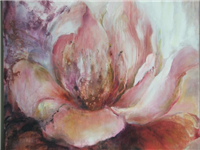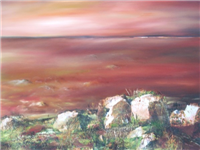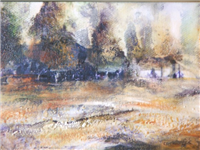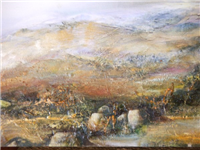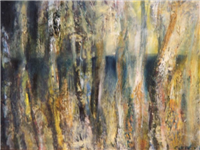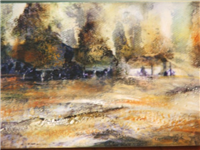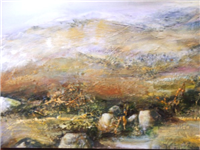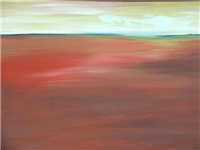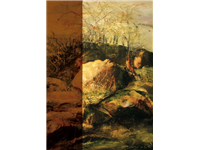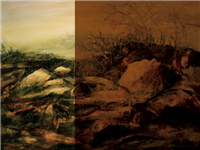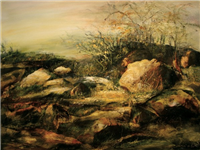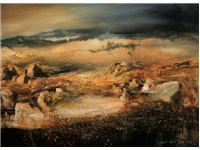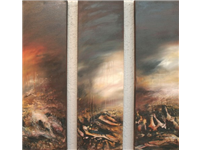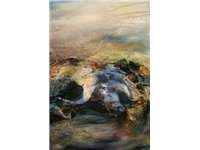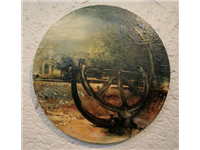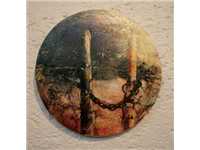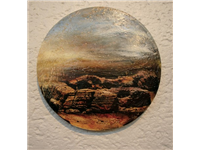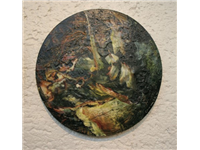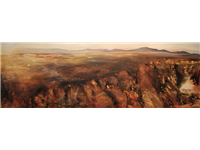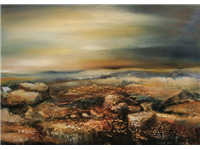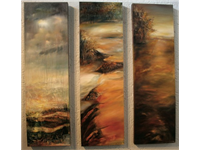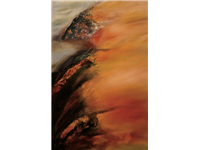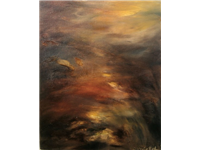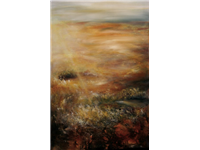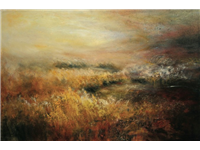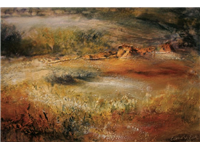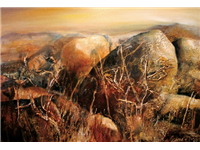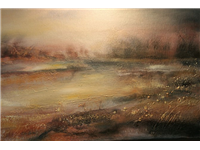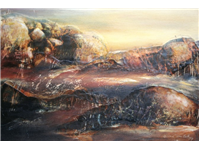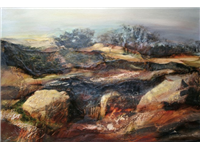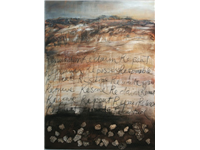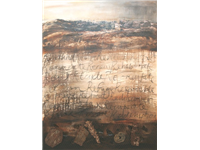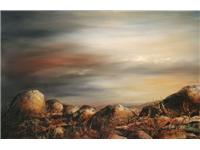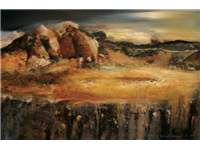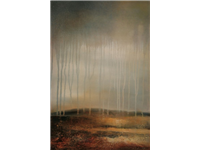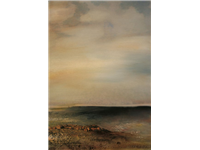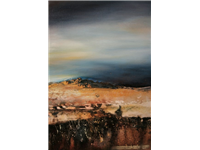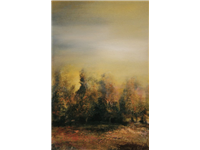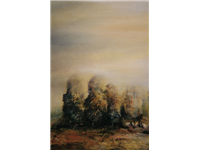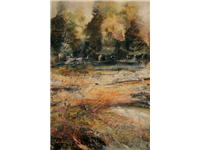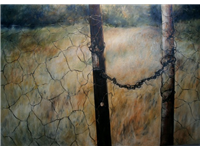


My Work
Mind-Land-Scapes
Interpretations of the South African Landscape
Corné van Eck transforms her landscape photographs into multi-media collages. She creates mindscapes by elaborating on portions of photographic material. Oils, combined with beeswax, bitumen, grass, bark and soil translates South African images into works of art. Each material is processed in such a way that they serve the composition as a whole.
Corné says that nature is the ideal environment for reflection and that she experiences a different form of spiritual consciousness when turning to nature for inspiration. “When I seek a composition to photograph, I attempt to become part of the surroundings by contemplating the atmosphere that the landscape generates. The time of day, light fall and textures play a central role.”
Corné’s paintings reflect the South African scenery in all its moods: tranquil, majestic, austere and robust. “I am moved by the land’s vastness, its mountains, rock formations and domed skies.”
Corné attempts to convince the viewer that the scenes she portrays are sacred places. She says that this, in itself, has symbolic value and can be seen as an expression of desolate land which is detached from society. “I endeavour to distance myself from the destructive influence that society’s worldliness has on spirituality in general. Thus the absolute absence of civilization in my work.”
Revival Field
A combined exhibition of landscapes and clay pots by Corné van Eck and Nic Sithole
Since the beginning of time, man has had, above all other creatures in the world a unique relationship with the earth. He has dug it up, formed items with it, decorated it and used it as a source of inspiration. This exhibition is about landscapes (Corné van Eck) and clay pots (Nic Sithole) that are combined to express the artists’ deep appreciation for the earth and its splendours or fear that these beauties may become degraded. It is a reminder to regenerate, revive, reshape, remould, renew, respect and recycle.
It is about our relation to the cosmos, the celebration of light as a positive sense of being, our connection to the earth as a place of worship, the meditation on life, death and loss, the brevity of our existence on earth, the healing power and refuge we should find in it and the strive to give three- and two-dimensional shape to these thoughts. Both artists have a personal, intimate, intuitive and revived relationship with the earth … Art and art making have the power to heal - as we experience the arts, we learn that the experience of loss can be transformed through art.
Both artists deal with the symbolism of a circle. The circle represents unity, time, universal cycles, life, eternity, sun and earth. It also symbolizes wholeness.
In some of the landscapes there are elements of decay, which represents the transience of our existence on earth. The remains of skulls (objects of death) serve as a reminder of the emptiness of life and the futility of human achievement. The use of decaying remnants, such as rusted metal and wire serve as a metaphor for the preservation of the land and memories.
In this exhibition the viewer is invited to rediscover his long forgotten relationship with the earth and the joy it brings.
Driekopseiland Rotsgravures
“Side road to the UNEXPECTED” (A closer glance at the Driekopseiland rock engravings - a re-discovery by Corné van Eck)
This exhibition explores one of South Africa’s most spectacular KhoiSan rock art sites located between Kimberley and Douglas in the Northern Cape. The engravings are set in the bed of the Riet River. I expected to find the traditional representational designs – eland, ostrich and hunter gatherers with bow and arrow. However, I was surprised to re-discover more than 3 500 geometric and abstract engraved images (or petroglyphs), more-or-less 5 to 50 cm in size and approximately 2 000 years old at this unique heritage site. Honeycomb patterns, sun and star images, grid ovals, dots, rectangular forms and fish spines all emanate from the rock. The canvas on which the engravings were made, was formed millions of years ago when glaciers scraped the primeval lava to prepare it for humans who later wanted to write and draw on it by knocking rock on rock. When the Riet River rises in the wet season, the engravings are submerged, but the site is left high and dry for most of the year, exposing an expressive expanse of rock.
What is the meaning behind these images?
The origin of the engravings is related to the puberty rites of young girls and is a reflection of marks that were made on the bodies and clothes of persons who were initiated. The KhoiSan also performed rituals of great emotional intensity which can be described as the trance dance (healing dance). Many of these engravings were possibly inspired by visions, called “Entoptics”, experienced during trance. The KhoiSan’s culture focuses on a concept called “N/um” (place a click where the / is). The word means a combination of power, wisdom and healing. It is this healing ability, this N/um, that has saved them from outright extinction.
Driekopseiland’s abstraction captured my imagination. I was confronted with unknown concepts from which I could make my own interpretations. One finds a connection with prehistoric times and experiences the presence of the artists. It is much more than a rock face. It was a pilgrimage to walk amongst these works of art; accompanied by David Morris, an archaeologist from Kimberley’s McGregor museum.
I invite the viewer to join me on a walk along this unknown side road and to re-discover parts of this remarkable and magical heritage site.
“Afdraaipad na die ONVERWAGSE” (’n Nader blik op die Driekopseiland gravures – ‘n herontdekking deur Corné van Eck)
Hierdie uitstalling verken een van die mees skouspelagtige rotskunsgebiede van die KhoiSan wat tussen Kimberley en Douglas in die Noord-Kaap geleë is. Die gravures se ligging is in die bed van die Rietrivier. Ek het die tradisionele voorstellende Boesmankuns verwag – eland, volstuis en jagter-versamelaars met pyl-en-boog. Ek was egter verbaas om meer as 3 500 geometriese en abstrakte gegraveerde motiewe (of petrogliewe), ongeveer 5 tot 50 cm groot en almal ongeveer 2 000 jaar oud, by hierdie unieke erfenisgebied te herontdek. Heuningkoekpatrone, son- en stervorme, kolle, ruitjieswerk, sirkels en visgrate ontvou uit die klip. Die skilderdoek waarop die rotsgravures uitgekap is, is miljoene jare gelede gevorm toe ysgletsers die oer-andesitiese lawa geskraap en voorberei het vir mense wat later daarop sou wou skryf of teken deur klip teen klip opmekaar te slaan om merke in die rots te maak. In die reëntyd word die gravures oorspoel deur die Rietrivierstroom, maar die res van die droë jaar word dit ontbloot.
Wat beteken hierdie motiewe?
Die oorsprong van die rotsgravures is verwant aan puberteits-rites van jong vroue en is ’n refleksie van merke wat aangebring is op die lywe en klere van mense wat geïnisieer is. Die helingskonsep, of “N/um” (maak ’n klikgeluid in die plek van die /), staan sentraal tot die KhoiSan kultuur. Dit verwys na ’n kombinasie van mag, wysheid en genesing. Die N/um het veral tydens die energieke beswymingsdanse langs die rivier plaasgevind. Hulle het moontlik hierdie simbole gehallusineer (“Entoptics”) waarna hul dit dan op die rots weergegee het.
Driekopseiland se abstraksie het my denke vir maande vasgevang. Ek is met onbekende konsepte gekonfronteer en kon my eie interpretasies daaruit maak. Mens vind ’n konneksie met die oertyd en ervaar die teenwoordigheid van die kunstenaars. Dit is veel meer as ’n klipbank. Dit was ‘n pelgrimsreis om saam met David Morris, ‘n argeoloog van Kimberley se McGregor-museum, tussen die werke te kon rondbeweeg.
Ek nooi die toeskouer om saam met my langs hierdie onbekende afdraaipad te stap en om meer van hierdie merkwaardige en magiese erfenis te her-ontdek.
Where Light meets the brush
(An exhibition that invites the viewer to stay/walk in the light)
Corné van Eck is inspired by the Impressionists whose work is characterized by the attempt to depict transitory visual impressions, often painted directly from nature, and by the use of pure broken colour to achieve brilliance and luminosity. They were in essence painters of “light”.
It is this essence of light that Corné wants to capture in her depiction of journeys through different Southern African landscapes.
Her landscapes emphasize the changing effects of light by using loose and spontaneous brushstrokes of highlighted colour. (“Each minute an ever-changing light transforms the atmosphere and beauty of things” Monet.)
Corné’s painting process is either one of starting plein-air drawings in pen and ink, or working from photographs to translate the images into oil paintings (some oil and collage) with vigorous brushstrokes. She also implements the fan brush to achieve a blurry effect like the work of Gerhard Richter and Michael Biberstein to create mood and atmosphere in the scenes she depicts.
There is a strong emotional value in Corné’s work in the sense that she urges the viewer to appreciate the character of light. Corné emphasizes that the focus on life must be on the mental lightness of being we create within ourselves. We are the painters of our own life dramas … eventually-the light will shine upon us … because she believes life can only be good when mental isolation and escape from gloom becomes possible.
This exhibition serves as a reminder to block out all pessimistic and negative experiences in our daily existence. We can learn to celebrate the positive in the midst of darkness. Corné invites the viewer to walk with her and experience Divine Light.
“And the light shines in darkness, and the darkness comprehended it not” John 1:5
(Dié uitstalling nooi die toeskouer om in die lig te bly/loop)
Corné van Eck word deurgaans beïnvloed deur die Impressioniste se werk wat gekenmerk word deur hul gebruik van spontane, vrye en gebroke kwashale om gloeiende en helder kleur te verkry. Hul was meesters in die skilder van lig.
Dis hierdie essensie van lig wat Corné wil weergee in haar uitbeeldings van verskeie reise deur die Suidelike Afrika-landskap.
Haar interpretasie van die landskap is ‘n momentele indruk van die werklikheid, verwasing van vorm en veranderende ligeffekte. (“Each minute an ever-changing light transforms the atmosphere and beauty of things” Monet.)
Corné se skilderproses begin meestal met pen-en inktekeninge in die buitelug, of voorsketse van haar fotografiese materiaal om dan vorm aan te neem in olieverfskilderye (soms olie en collage) met ongekontroleerde kwashale. Sy implementeer die waaierkwas om verwasing van vorm toe te pas soos in die werk van Gerhard Richter en Michael Biberstein ten einde atmosferiese perspektief te skep.
Daar is sterk emosionele waarde in Corné se werk in die opsig dat sy die toeskouer aanmoedig om die simboliek van lig te waardeer … dat ons moet fokus op wat die lig-konsep vir ons versinnebeeld ten opsigte van ons psigiese ingesteldheid. Ons is die skilders van ons eie lewensdramas … as ons dit kan regkry om onsself te distansieer van negatiwiteit en sodoende emosionele ontvlugting daarvan te bewerkstellig … sal die lig vir ons skyn.
Hierdie uitstalling dien as herinnering daaraan dat ons die positiewe kan vier te midde van duister aspekte in ons daaglikse bestaan. Corné nooi die toeskouer om hierdie pad van lig saam met haar te stap en ervaar.
“Die lig skyn in die duisternis, die duisternis kon dit nie uitdoof nie.” Joh 1:5
